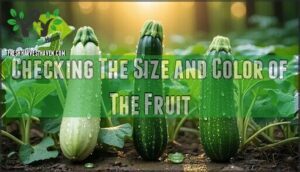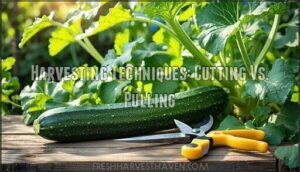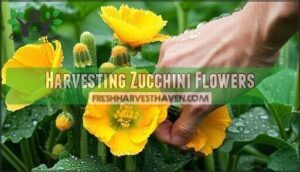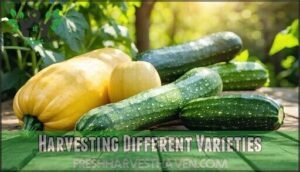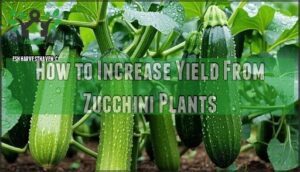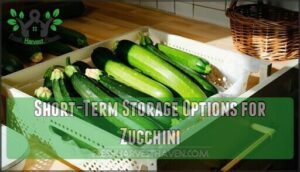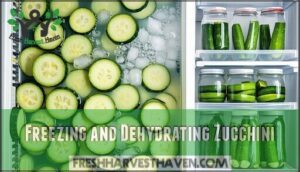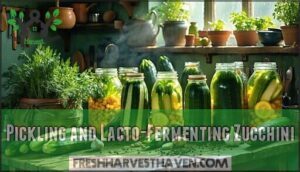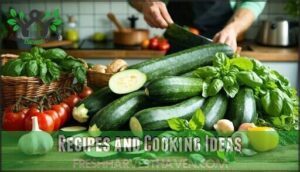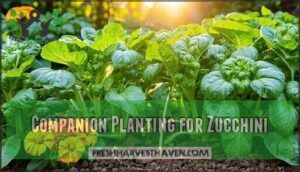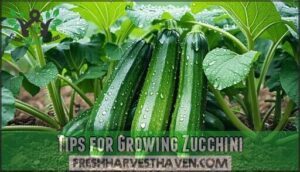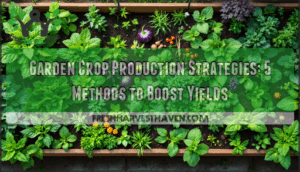This site is supported by our readers. We may earn a commission, at no cost to you, if you purchase through links.
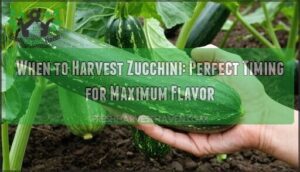 You’ll know when to harvest zucchini by checking the size—they’re perfect at 6-8 inches long, about the length of a dollar bill.
You’ll know when to harvest zucchini by checking the size—they’re perfect at 6-8 inches long, about the length of a dollar bill.
At this stage, the skin’s tender enough to pierce with your fingernail, and the flavor’s at its peak.
Don’t wait too long or you’ll end up with a woody baseball bat that’s only good for composting.
Check your plants daily since zucchini can double in size overnight during peak season.
The key is catching them while they’re still glossy and firm, with a slight give when gently squeezed.
Master this timing and you’ll discover some surprising tricks that’ll keep your plants producing all season long.
Table Of Contents
- Key Takeaways
- Zucchini Harvesting Basics
- How to Harvest Zucchini
- Ideal Time for Harvest
- Harvesting Different Varieties
- How to Increase Yield From Zucchini Plants
- Storing and Preserving After Picking
- Recipes and Cooking Ideas
- Common Problems and Solutions
- Companion Planting for Zucchini
- Tips for Growing Zucchini
- Frequently Asked Questions (FAQs)
- How long should a zucchini be before harvesting?
- When is the best time to pick zucchini?
- When to harvest zucchini squash?
- How do you know when to harvest zucchini?
- How often should you pick zucchini?
- How long does it take a zucchini to grow?
- What happens if you leave zucchini on the vine too long?
- How do you know when a zucchini plant is done producing?
- Does harvest time affect the taste of zucchini?
- Can you grow zucchini if summer is short?
- Conclusion
Key Takeaways
- Harvest at 6-8 inches long – You’ll get the best flavor and tender texture when your zucchini reaches this size, about the length of a dollar bill.
- Check daily during peak season – Zucchini can literally double in size overnight, so you’ll need to inspect your plants every day to catch them at their prime.
- Look for glossy, firm skin – You’ll know they’re ready when the skin has a shiny appearance and yields slightly to gentle pressure from your fingernail.
- Harvest regularly to keep production going – You’ll trigger more fruit production by picking every 2-3 days, as leaving oversized zucchini on the vine signals the plant to stop producing.
Zucchini Harvesting Basics
You’ll know it’s time to harvest your zucchini when they reach 6-8 inches long and feel firm to the touch – any bigger and they’ll turn into baseball bats that taste like cardboard.
The key is checking your plants daily during peak season, since these green speed demons can literally double in size overnight and go from perfect to overgrown faster than you can say "zucchini bread.
This rapid growth means that daily checks are crucial to avoid missing the optimal harvest time.
Types of Zucchini and Their Harvesting Periods
When you’re planning your zucchini harvest, understanding variety differences makes all the difference between bland, overgrown squash and perfectly tender vegetables.
Different zucchini varieties reach peak ripeness at distinct intervals, and knowing these timing windows helps you catch every fruit at its flavor peak. Most varieties mature within 45-55 days after planting, but variety differences substantially impact when to pick zucchini.
Classic green zucchini like Black Beauty should be harvested when 6-8 inches long with glossy, dark green skin. The color indicators tell you everything—dull skin means you’ve waited too long.
Pattypan zucchini offers the best texture when picked at 2-4 inches diameter, typically 45-70 days after planting. These scalloped beauties are ready when they’re baseball-sized.
Round zucchini varieties like Eight Ball reach perfect zucchini size at 3-4 inches wide, usually around 45-50 days from planting.
Here’s what matters most when harvesting zucchini:
- Heirloom varieties often take longer to mature but offer superior flavor
- Hybrid maturity tends to be more predictable and disease-resistant
Shape matters too—crookneck types should be picked when necks stay flexible at 4-6 inches long for ideal tenderness. A single, healthy plant can have a high yield, producing up to nine pounds in a season.
Factors Affecting Zucchini Harvest Time
Several factors determine when your zucchini will be ready for harvest, making timing more art than science.
Weather plays the biggest role – warm, sunny days speed up zucchini growing while cool spells can delay maturity by weeks. Your soil temperature should stay consistently above 60°F for ideal growth.
Here are the key factors affecting your zucchini harvest time:
- Soil Temperature – Cool soil slows development substantially
- Sunlight Exposure – Six to eight hours daily accelerates fruit production
- Watering Practices – Consistent moisture keeps plants on schedule
- Nutrient Availability – Well-fed plants produce earlier, larger yields
- Variety Selection – Different types mature anywhere from 35-75 days
Most gardeners find their ripe zucchini ready around 50 days after germination, but don’t rely on calendar dates alone. Your specific growing conditions create a unique timeline. Check your seed packet for variety-specific maturity dates, then adjust based on your local weather patterns and soil quality. Regular harvesting zucchini at the right zucchini size keeps production flowing smoothly.
Importance of Harvesting Zucchini at The Right Time
Your garden’s productivity hinges on mastering zucchini harvest time. Flavor and texture peak when you pick zucchini at 6-8 inches long—wait too long, and you’ll get tough, stringy squash that’s barely edible.
Plant productivity suffers dramatically when oversized fruits stay on the vine, signaling your plant to stop producing new zucchini. You’re basically telling it "job done" when you leave baseball-sized monsters hanging around.
Harvesting zucchini every 2-3 days keeps production flowing and maximizes nutritional value before seed development begins. Ripe zucchini should feel firm with glossy skin—soft spots mean you’ve waited too long.
Morning harvests capture peak flavor while avoiding waste from overripe specimens. Perfect harvest timing means tender, sweet zucchini that’ll make your neighbors jealous of your endless summer bounty.
How to Harvest Zucchini
Once you know when to harvest, you’ll need to master the proper techniques to avoid damaging your precious zucchini plants.
The way you remove the fruit from the vine can make the difference between a thriving plant that keeps producing and one that struggles to recover from rough handling.
Checking The Size and Color of The Fruit
Your zucchini’s appearance tells you everything about optimal size and readiness. Ripe zucchini should measure 6-8 inches long with glossy, unblemished skin that practically glows in sunlight. Color indicators vary by variety—deep green for traditional types, bright yellow for golden cultivars.
Check for these variety differences when harvesting zucchini:
- Size: Standard varieties at 6-8 inches, round types at baseball size
- Color: Vibrant, consistent hue without dull patches
- Skin texture: Smooth, glossy surface that resists fingernail scratches
- Underripe signs: Pale color, very small size, tender skin
- Overripe signs: Dull appearance, hard skin, visible seed bumps
Feel for firm flesh that yields slightly when pressed—this indicates perfect ripeness without being tough or seedy.
Harvesting Techniques: Cutting Vs. Pulling
Once you’ve identified the perfect zucchini, cutting advantages become clear—pulling risks damaging your plant’s delicate stems and reducing future harvests. Always use knife or pruning shears for picking zucchini.
Here’s your foolproof harvesting technique:
- Support the fruit with one hand while making your cut
- Slice cleanly through the stem, leaving 1-2 inches attached
- Make an angled cut to prevent moisture buildup and plant damage
Tool sterilization prevents disease spread between plants. Clean cuts maintain proper stem length while protecting your zucchini plant’s productivity for weeks to come.
Tools Needed for Harvesting Zucchini
Equip yourself with the right harvesting tools to make zucchini picking effortless and safe. Sharp tools prevent plant damage while protecting your hands from prickly stems.
| Tool Type | Purpose |
|---|---|
| Sharp knife or pruning shears | Clean cuts without damaging plants |
| Thick gardening gloves | Protection from rough leaves and stems |
| Sterilized scissors | Precise cutting for delicate harvests |
| Collection basket | Organized harvest transport |
Knife sharpness matters most—dull blades crush stems and invite disease. Pruner types vary, but bypass pruners work best for zucchini’s tender stems. Quality harvesting tools make the difference between stressed plants and thriving ones.
Consider investing in high quality shears for ideal zucchini harvesting. Glove options include leather or thick canvas for maximum protection.
Sterilization methods involve wiping blades with rubbing alcohol between plants. Container selection depends on harvest size—shallow baskets prevent bruising your bounty. Quality harvesting tools make the difference between stressed plants and thriving ones.
Harvesting Zucchini Flowers
Beyond your zucchini harvest, those bright yellow blooms on your plants offer another delicious opportunity. Zucchini flowers aren’t just pretty—they’re a gourmet ingredient waiting to grace your kitchen table.
Flower Harvesting Time matters for peak flavor and texture. Here’s your step-by-step approach:
- Identify flower types – Male flowers have thin stems and thick stamens, while female blooms show tiny zucchini bulges at their base
- Harvest in early morning when flowers are fully open but haven’t wilted from afternoon heat
- Snip male flowers just below the bloom, leaving several on each plant for pollination
- Collect female flowers sparingly since they’ll become your future zucchini crop
Flower Preparation starts with gentle handling. Flower Storage Tips include refrigerating between damp paper towels for up to two days. Culinary Uses range from cheese-stuffed preparations to crispy tempura batters. Flower Nutritional Value includes vitamin C and antioxidants, making these edible flowers both tasty and nutritious additions to your meals.
Ideal Time for Harvest
You’ll get the best flavor and texture when you harvest zucchini at just the right moment – too early and you’ll miss out on peak taste, too late and you’ll end up with a baseball bat instead of dinner.
Timing your harvest correctly means checking your plants daily and knowing exactly what signs to look for, which is crucial for achieving the best flavor.
Harvesting Zucchini in The Morning
Early morning’s cool embrace delivers your zucchini’s peak flavor and crispest texture.
Harvesting before 9am captures maximum moisture content, creating heavier, more vibrant squash that stays fresh longer.
pollination
Dew effects enhance cellular structure while reducing plant stress from heat.
This early morning harvest timing encourages continuous production throughout zucchini season, making your picking routine both productive and pleasant.
Harvesting Zucchini at The Right Stage of Maturity
When your zucchini reaches the perfect stage of maturity, you’ll notice distinct signs that guarantee optimal size and peak flavor. The magic happens when your squash hits that sweet spot between too young and overgrown.
Maturity indicators tell the whole story:
- Size matters: Standard varieties should measure 6-8 inches long, while round types reach baseball size
- Skin test: Firm exterior that yields slightly to gentle fingernail pressure indicates perfect tenderness
- Color consistency: Deep, uniform, vibrant hues across the entire fruit surface
- Glossy appearance: Shiny skin without any hardening spots or dull patches
Harvesting at this stage prevents texture changes that occur when zucchini becomes oversized. Once fruits exceed their optimal size, seed development accelerates, creating tough, stringy interiors that lack the tender qualities you want.
Flavor impact peaks during this maturity window. Wait too long, and you’ll get watery, bland squash instead of the sweet, nutty taste that makes ripe zucchini so delicious in your favorite recipes.
How to Check for Readiness
Determining readiness requires careful observation of several key indicators. You’ll want to examine your zucchini systematically before harvesting to guarantee peak flavor and tenderness.
Size Matters most—harvest when zucchini reaches 6-8 inches long and feels substantial but not heavy. Skin Texture should be glossy and firm, yielding slightly to gentle pressure without denting. Check the Stem Condition for freshness; it should appear green and moist, not dried or brown.
Here’s your readiness checklist:
- Blossom End inspection—look for a clean, dry end without soft spots or discoloration
- Weight Assessment—ripe zucchini feels firm but not dense like a baseball bat
- Tenderness test—gently press your thumbnail into the skin; it should pierce easily
Don’t wait too long—zucchini can transform from perfect to baseball bat overnight!
Harvesting Different Varieties
Different zucchini varieties have their own sweet spots for harvesting, and knowing when each type is ready can make the difference between tender, flavorful squash and tough, seedy disappointments.
You’ll want to check pattypan varieties when they’re about 3-4 inches across, round zucchinis at baseball size, and crookneck types when they’re 4-6 inches long with their characteristic curved neck still tender.
When to Harvest Pattypan Zucchini
The perfect pattypan squash resembles a tiny flying saucer ready for harvest! Pick these summer squash when they’re 2-4 inches in diameter, typically appearing 45-70 days after planting.
Pattypan squash thrives in a location with full sun conditions for ideal growth. Pattypan Size matters—smaller ones offer better Tenderness Test results.
Harvesting Frequency should be every 1-2 days during peak season. Variety Differences among garden vegetables mean timing varies, but these squash varieties reward frequent picking with continuous production.
When to Harvest Round Zucchini
Round zucchini varieties like ‘Eight Ball’ demand a different approach than their elongated cousins. These compact treasures reach peak quality at specific sizes, making timing vital for maximum flavor.
Your round zucchini is ready when it reaches ball size – typically 2-4 inches in diameter for best texture and taste. Here’s what to watch for:
- Skin firmness should yield slightly to gentle pressure but feel solid
- Ripeness indicators include glossy, vibrant skin without dull patches
- Size matches a tennis ball for tender eating, baseball for stuffing
- Fresh stem attachment with no withering or browning
Harvest frequency matters – check daily since these grow incredibly fast. Variety differences mean lighter types may show readiness differently than dark green ones. Taste testing a small sample helps you learn your preferred size.
Morning harvesting preserves firmness and extends storage life. Cut cleanly with sharp tools, leaving a small stem attached. Don’t let them exceed 5 inches, as they’ll develop tough skin and large seeds.
When to Pick Crookneck Zucchini
Catch crookneck zucchini at their golden peak for the best eating experience. These curved beauties are ready when they’re 4-6 inches long with glossy, tender skin.
| Harvest Indicator | What to Look For |
|---|---|
| Crookneck Size | 4-6 inches long |
| Crookneck Color | Bright yellow, glossy |
| Crookneck Firmness | Tender skin, firm flesh |
| Crookneck Maturity | Before seeds harden |
Check daily since they grow fast! Use sharp pruners, leaving a small stem. Crookneck Storage is limited—use within days for peak flavor and texture.
How to Increase Yield From Zucchini Plants
You’ll get more zucchini than you can handle when you harvest regularly and keep your plants well-fed.
The secret lies in picking young fruits every few days, which tricks the plant into producing more, plus ensuring they get plenty of water and nutrients to fuel that rapid growth.
Frequent Harvesting and Its Benefits
Your zucchini plants reward frequent harvesting with explosive Continuous Production—it’s nature’s way of saying "thank you."
Daily checks for 6-8 inch fruits trigger Yield Maximization while preserving peak flavor and tender texture.
Here’s why consistent frequent harvest transforms your garden:
- Stimulates flower production – Each cut signals more blooms
- Maintains Plant Health** – Reduces stress and disease risk
- Ensures Flavor Enhancement** – Small zucchini taste infinitely better
- Prevents Overgrowth** – Nobody wants baseball bat-sized surprises
Harvesting every other day keeps plants producing through summer.
Using sharp pruning shears is key to avoiding plant damage.
Those sneaky squash hiding under leaves can double overnight, so regular scouting prevents flavor-robbing giants.
Your zucchini will thank you with tender, sweet harvests all season long.
Providing Adequate Nutrients and Water
Beyond frequent harvesting, proper nutrition and watering transform mediocre plants into prolific producers.
Soil pH between 6.0-7.0 guarantees maximal nutrient absorption, while nutrient-rich soil feeds hungry zucchini plants.
Apply balanced fertilizer types like 10-10-10 every 3-4 weeks during growing season—think of it as feeding a teenager who’s constantly growing.
Watering frequency matters more than volume.
Deep watering 1-2 inches weekly beats daily sprinkles.
Water quality affects plant health, so avoid softened water high in sodium.
Monitor soil conditions and soil temperature—warm, moist soil encourages root development.
Fertilizing with compost tea monthly introduces beneficial microorganisms.
Watch for yellowing leaves indicating nutrient deficiency.
Mulching retains moisture while suppressing weeds, creating perfect growing conditions.
Hand Pollination Techniques
When nutrients and water aren’t enough to boost your zucchini harvest, manual pollination becomes your secret weapon.
This technique doubles or triples yields when natural pollinators are scarce.
Here’s your step-by-step approach:
- Identify the players: Male flowers have thin stems and visible stamen, while female flowers sport a tiny zucchini at their base – like nature’s own pregnancy test.
- Perfect your timing: Collect pollen between 6-10 AM when flowers are fully open and pollen is most viable. Use a small paintbrush or cotton swab for gentle pollen collection.
- Make the connection: Transfer pollen from male to female flowers by brushing the stigma center. One male flower can pollinate 3-5 females.
Success indicators include fruit development within days of pollination.
Storing and Preserving After Picking
Once you’ve harvested your zucchini, proper storage keeps them fresh and flavorful for weeks or even months.
You’ll want to choose the right preservation method based on how quickly you plan to use them and your preferred cooking applications.
Short-Term Storage Options for Zucchini
Once you’ve boosted your zucchini harvest, proper storage keeps your bounty fresh and flavorful. Smart refrigeration methods make all the difference between crisp vegetables and mushy disappointments.
Your freshly picked zucchini needs the right environment to maintain its garden-fresh quality. Store unwashed zucchini in your crisper drawer using perforated plastic bags—the perforation benefits include proper air circulation while maintaining humidity.
This shortterm storage method keeps zucchini fresh for up to a week.
- Counter storage: Perfect for 1-2 days in a cool place away from direct sunlight
- Refrigerator storage: Place on a paper towel inside perforated bags for extended freshness
Avoiding washing before storage prevents moisture buildup that accelerates spoilage. Only rinse right before cooking. Handle gently to prevent bruising, which shortens shelf life substantially.
Remember, slightly immature zucchini actually stores better than fully mature ones!
Freezing and Dehydrating Zucchini
While short-term storage keeps your zucchini fresh for days, long-term preservation lets you enjoy that summer harvest year-round.
Blanching methods are your first step for freezing—drop sliced zucchini into boiling water for exactly three minutes, then plunge into ice water.
This preserves color and texture.
For shredded zucchini, you can skip blanching entirely.
Spread pieces on cookie sheets before transferring to freezerproof containers or vacuum-sealed bags.
Proper storage requires durable containers for frozen goods.
Dehydrator settings should run at 135°F for 8-12 hours until pieces snap cleanly.
No dehydrator?
Your oven works too—just prop the door open slightly.
Store dried zucchini in airtight containers with shelf life extending up to one year.
Rehydration techniques vary by use:
soak dried pieces in warm water for soups,
or grind into powder for thickening sauces.
Your future self will thank you when winter arrives!
Pickling and Lacto-Fermenting Zucchini
While freezing locks in freshness, pickling and fermenting turn your zucchini harvest into probiotic powerhouses that pack serious flavor punch.
These preservation methods transform humble garden vegetables into tangy, gut-healthy treats that’ll last months.
Choose firm, freshly harvested zucchini for best texture and fermentation safety. Smaller zucchini work perfectly since they maintain their crunch better than oversized ones.
Quick pickling creates sweet pickles ready in 24-48 hours, while lacto-fermentation develops complex flavors over 10-14 days.
Your zucchini preservation toolkit:
- Create pickling brines with vinegar, salt, sugar, and spices like dill or mustard seeds
- Try spicy zucchini pickles with jalapeños and garlic for extra kick
- Keep fermented zucchini submerged under brine to prevent mold
- Store finished pickles refrigerated for up to 12 months.
Lacto-fermentation benefits include increased vitamins, beneficial enzymes, and over 15 species of helpful bacteria that support digestion.
Recipes and Cooking Ideas
Now that you’ve harvested your zucchini at the perfect time, you’re ready to transform those tender, flavorful vegetables into delicious meals.
From quick grilled slices to hearty baked goods, properly timed zucchini makes all the difference in your kitchen creations, with delicious meals being the ultimate goal.
Grilled and Roasted Zucchini Recipes
Once you’ve mastered harvesting zucchini at the perfect 6-8 inch size, grilling and roasting reveal incredible flavor potential.
These cooking methods caramelize the natural sugars, creating depth that raw zucchini simply can’t match.
For grilling techniques, slice your zucchini into ¼-inch planks or rounds. Brush with olive oil and season generously—garlic powder and oregano make excellent flavor pairings. Grill 3-4 minutes per side until beautiful char marks appear.
Roasting methods offer hands-off convenience. Halve zucchini lengthwise, drizzle with olive oil, and roast at 400°F for 15-20 minutes until caramelized.
Lemon & herbs
Parmesan & garlic
Balsamic glaze
Mint & feta
Recipe variations include stuffed zucchini boats with breadcrumbs and cheese, or ribbon-cut zucchini for elegant presentation. These serving suggestions highlight your garden’s bounty while preserving that fresh-harvested flavor you’ve worked hard to achieve.
Zucchini Noodle and Stir-Fry Recipes
Fresh zucchini transforms into satisfying meals when you know the right techniques. Your spiralizer becomes your best friend for creating perfect zoodles that won’t turn mushy. The secret lies in understanding zucchini’s high water content and adjusting your cooking methods accordingly.
- Salt your zoodles for 10 minutes before cooking to remove excess moisture
- Keep stir-fry heat high to prevent soggy vegetables and maintain crispness
- Add zucchini last in stir-fries to preserve texture and nutritional benefits
- Experiment with sauce ratios – less liquid prevents watery dishes
- Try different cuts – ribbons, cubes, or spirals offer unique recipe adaptations
Your harvest’s culinary uses expand dramatically with proper zoodle texture management. Consider companion planting benefits to improve soil health for future harvests. Quick cooking preserves fresh zucchini’s delicate flavor while maintaining its nutritional benefits. These cooking methods guarantee your garden-to-table zucchini recipes shine every time.
Baked Goods and Desserts Using Zucchini
Your garden’s overflowing with zucchini? You’re sitting on a goldmine for incredible baked goods and desserts! Zucchini bread remains the ultimate crowd-pleaser, delivering moist, tender slices that’ll have neighbors knocking on your door.
Chocolate zucchini brownies and cake recipes cleverly disguise vegetables in decadent treats. Zucchini muffins make perfect breakfast treats, especially when you fold in blueberries or chocolate chips.
For sweet variations, try lemon-zucchini bars with tangy glaze or spiced zucchini donuts. The secret? Grated zucchini adds incredible moisture without any veggie flavor.
Your zucchini recipes transform excess harvest into freezer-friendly treasures. Baking with zucchini means you’ll never waste another oversized squash again – just shred, measure, and bake your way to delicious success!
Common Problems and Solutions
Even experienced gardeners encounter challenges when growing zucchini, from oversized fruit to pest problems.
Understanding how to troubleshoot these common issues will help you maintain a healthy, productive zucchini patch all season long, which is crucial for a successful harvest and involves troubleshoot.
What to Do With Overripe Zucchini
Nobody enjoys discovering a baseball-sized zucchini hiding under those broad leaves.
When you’ve got overripe, mealy giants with tough skin and bitter undertones, don’t toss them in the trash. Here’s how to salvage your garden surprise:
- Zucchini Bread – Shred the flesh after removing seeds for moist, delicious loaves
- Stuffed Zucchini – Hollow out and fill with savory rice or meat mixtures
- Zucchini Fritters – Grate and mix with herbs for crispy golden patties
- Animal Feed – Chickens and rabbits love these nutritious treats
- Compost Material – Add to your pile for rich soil amendment
Save those seeds for next year’s garden too!
How to Handle Zucchini Pests and Diseases
Protecting your zucchini plants from pests and diseases starts with proper pest identification. Squash bugs, cucumber beetles, and vine borers are your main enemies, while powdery mildew and bacterial wilt threaten plant health.
Daily monitoring beats reactive treatment every time. Check leaf undersides for egg clusters and inspect stems for borer holes. Yellowing leaves often signal disease onset, so act quickly when you spot trouble.
For organic controls, neem oil tackles soft-bodied insects effectively, while diatomaceous earth creates barriers against crawling pests. Hand-picking works surprisingly well for larger insects like squash bugs.
Disease prevention trumps treatment—avoid overhead watering and make certain good air circulation. Choose resistant varieties when possible, and practice crop rotation to break pest cycles.
Chemical treatments remain backup options when organic remedies fail, but integrated pest management combining multiple approaches yields the best results for long-term garden health.
Dealing With Zucchini Plants That Are Not Producing
Many zucchini plants become stubborn non-producers, leaving gardeners wondering where they went wrong.
When your plants refuse to deliver the harvest you’re expecting, these troubleshooting steps can restore their productivity:
- Pollination problems – Without enough bees, hand-pollinate using a small paintbrush to transfer pollen from male flowers (thin stems) to female flowers (tiny zucchini bases).
- Soil nutrients – Nutrient-starved plants need balanced fertilizer to jumpstart fruit yields and restore vigor.
- Watering issues – Inconsistent moisture stresses your zucchini plant; maintain steady watering without waterlogging roots.
- Pest control – Squash bugs and vine borers devastate production, so inspect regularly and treat infestations promptly.
One solution is to explore organic pest control for these infestations.
Remember, proper sunlight exposure combined with consistent care transforms struggling plants into productive powerhouses that’ll have you begging neighbors to take excess zucchini!
Companion Planting for Zucchini
You’ll find that certain plants can actually help your zucchini thrive while protecting it from pests and diseases.
Smart companion planting maximizes your garden space and also creates a natural support system that keeps your zucchini plants healthier and more productive.
How to Plant and Care for Companion Plants
The secret to successful companion planting lies in strategic placement and proper care of your zucchini’s garden allies.
When you establish this garden partnership, you’ll create a thriving ecosystem that naturally protects and enhances your zucchini harvest. Smart companion planting transforms your garden into a self-sustaining system where each plant serves multiple purposes.
Here’s your companion planting roadmap:
- Plant pollinator attractors like borage and sweet alyssum within 2-3 feet for enhanced bee attraction and beneficial insects
- Position pest deterrents including marigolds and nasturtiums around your zucchini perimeter for natural protection
- Add nitrogen-fixing legumes such as beans or peas nearby for ongoing soil improvement without extra fertilizers
- Install vertical supports for climbing companions to maximize space optimization while providing growth support
- Maintain 18-24 inches spacing between plant groups to guarantee proper airflow and prevent overcrowding
Regular watering and weeding keep your companion plants healthy and effective. This pollination-boosting strategy creates a balanced ecosystem where every plant contributes to your zucchini’s success through natural pest control and enhanced soil fertility.
Benefits of Companion Planting for Zucchini
Why settle for struggling plants when companion planting can transform your zucchini garden into a thriving ecosystem? Strategic companion planting creates natural partnerships that boost your harvest while reducing maintenance.
Here are three powerful benefits you’ll gain:
- Pest Control – Marigolds and nasturtiums repel squash bugs and cucumber beetles, while garlic and onions release sulfur compounds that deter aphids. Radishes even chase away squash vine borers.
- Pollination Boost – Borage, sweet alyssum, and calendula attract bees and beneficial insects to your zucchini flowers. Since each fruit needs at least six bee visits for full pollination, these flowering companions directly increase your yield.
- Soil Health – Beans and peas fix nitrogen in the soil, enriching it for heavy-feeding zucchini plants. Clover acts as living mulch, retaining moisture and suppressing weeds while improving soil aeration.
This space optimization approach creates disease prevention through improved airflow and attracts beneficial insects that provide natural growth support. You’re basically building a self-sustaining garden community.
Tips for Growing Zucchini
Growing zucchini successfully starts with picking the right variety for your local weather conditions and soil type.
You’ll also need to focus on proper soil preparation, smart fertilization, and giving your plants the perfect balance of sunlight and water they crave, which includes smart fertilization.
Choosing The Right Variety for Your Climate
Your garden’s success starts with picking zucchini varieties that match your specific climate zones.
Check your seed packet for days to harvest—this number tells you everything about timing success in your growing season.
| Climate Type | Best Varieties | Key Advantage |
|---|---|---|
| Cool/Short Season | Black Beauty, Costata Romanesco | Mature in 50-52 days |
| Hot/Humid | Dunja F1, Success PM | Strong disease resistance |
| Dry/Arid | Desert F1, Tromboncino | Excellent drought tolerance |
| All-Purpose | Ambassador, Grey Zucchini | Reliable hybrid vigor |
Regional favorites often outperform generic varieties because they’re bred for local conditions.
Heirloom options like Cocozelle offer unique flavors, while hybrid vigor provides consistent yields and disease resistance.
Think of variety selection as choosing the right tool for your specific job—you wouldn’t use a hammer for everything, right?
Smart gardeners match their vegetable varieties to their growing conditions, not the other way around, which leads to better results and more successful harvests.
Soil Preparation and Fertilization
Your soil foundation sets the stage for bountiful zucchini harvests. Start with soil testing to check your pH balance—zucchini thrives in slightly acidic to neutral conditions between 6.0-7.5. Most home testing kits cost under $10 and provide accurate readings.
Transform ordinary dirt into nutrient-rich soil by working 3-4 inches of compost or aged manure into the top 8 inches. This organic amendment feeds your plants while improving drainage—nobody wants waterlogged zucchini roots! Soil preparation includes creating raised beds or mounds to prevent soggy conditions.
You can find a suitable soil testing kit online. When flowers appear, apply balanced fertilizer (10-10-10 works great) to meet your plants’ nutrient needs. Container growers should use quality potting mix with excellent drainage holes.
- Quick tip: Clay soil? Add coarse sand and compost; sandy soil benefits from extra organic matter for moisture retention.
Providing Adequate Sunlight and Water
Your zucchini plants need sunlight like morning coffee—absolutely essential! Place them where they’ll receive six to eight hours of direct sunlight daily for ideal growing conditions.
For watering frequency, think deep drinks rather than daily sips. Check soil moisture by inserting your finger one inch down—if it’s dry, it’s time to water. Drainage importance can’t be overstated; soggy roots spell disaster.
Watch for signs of stress like yellowing leaves, which often indicate overwatering or poor drainage.
Frequently Asked Questions (FAQs)
How long should a zucchini be before harvesting?
Imagine this scenario: you’re checking your garden and find a perfect green cylinder hiding under broad leaves.
Harvest zucchini when they’re 6-8 inches long for the best flavor and tender texture.
Any bigger and they’ll turn stringy.
When is the best time to pick zucchini?
Pick zucchini when they’re 6-8 inches long for best flavor and texture.
Harvest every few days using a sharp knife, cutting at the stem.
Daily checking prevents oversized, tough squash that’ll slow future production, which is a complete concept to keep in mind for maintaining productivity.
When to harvest zucchini squash?
Lightning-fast growth means you’ll harvest zucchini when they’re 6-8 inches long, about 50-60 days after planting.
Cut them with a sharp knife daily—they’ll practically double overnight if you’re not watching!
How do you know when to harvest zucchini?
Check for firm, dark green zucchini that’s 6-8 inches long with glossy skin. Harvest when it’s still tender – if your fingernail doesn’t easily pierce the skin, it’s overripe.
How often should you pick zucchini?
You should harvest zucchini daily once they start producing. Frequent picking keeps the plant cranking out more fruit, while leaving zucchini on the vine signals it’s done producing.
How long does it take a zucchini to grow?
Green shoots emerge from soil like nature’s own magic trick, transforming tiny seeds into prolific producers.
Your zucchini plants start flowering after 45-55 days, then begin producing fruit just 50-60 days after sowing seeds in warm soil.
What happens if you leave zucchini on the vine too long?
If you leave zucchini on the vine too long, they’ll become oversized giants with tough, bitter skin and stringy, seedy flesh that’s basically inedible.
Think baseball bat texture instead of tender vegetable.
How do you know when a zucchini plant is done producing?
Like a tired marathon runner slowing down, your zucchini plant signals its finale when production drops dramatically.
Leaves yellow and wilt, and stems become woody, typically after 60-80 days of harvest.
Does harvest time affect the taste of zucchini?
Yes, harvest timing dramatically affects zucchini’s taste.
Young zucchini (6-8 inches) offers tender flesh and mild flavor, while oversized ones become stringy, tough, and bitter.
You’ll get the sweetest, most delicate taste when you harvest early and often.
Can you grow zucchini if summer is short?
Racing against time’s ticking clock?
You can definitely grow zucchini in short summers.
Choose fast-maturing varieties that’ll produce fruit in just 45-55 days from sowing, giving you plenty of delicious harvests.
Conclusion
Mastering when to harvest zucchini will transform your garden from a chaotic jungle into a productive paradise.
You’ll enjoy tender, flavorful zucchini all season long by picking them at 6-8 inches when they’re still glossy and firm.
Check daily during peak growing season, harvest in the morning, and don’t forget those edible flowers.
Regular picking encourages more production, so you’ll never run out of delicious zucchini for your favorite recipes, ensuring a continuous supply of tender zucchini.

